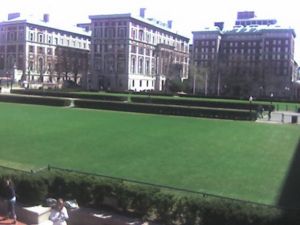Difference between revisions of "South Lawn"
| Line 3: | Line 3: | ||
'''South Lawn''' refers to the two fields between [[Butler Library]] and [[College Walk]]. Access to the fields is signaled by flags posted at the corner of the field. Green flags signal an open field, red signal closed. Sadly, the fields are almost always closed (or one of them is closed), as indicated by the red flags. In the winter, they're usually concealed (along with the other [[Lawn|lawns]]) by white tarps to protect them from the elements, so you can't even see them. They do this to make sure they look good for [[Commencement]], when the lawns are instead covered in sea of folding chairs. Honestly, you can't make this stuff up. | '''South Lawn''' refers to the two fields between [[Butler Library]] and [[College Walk]]. Access to the fields is signaled by flags posted at the corner of the field. Green flags signal an open field, red signal closed. Sadly, the fields are almost always closed (or one of them is closed), as indicated by the red flags. In the winter, they're usually concealed (along with the other [[Lawn|lawns]]) by white tarps to protect them from the elements, so you can't even see them. They do this to make sure they look good for [[Commencement]], when the lawns are instead covered in sea of folding chairs. Honestly, you can't make this stuff up. | ||
| − | + | According to legend, royalties from the film ''Ghostbusters'' pays for the lawn's maintenance. | |
| − | + | ==History of South Field== | |
| + | In terms of historical campus geography, the term '''South Field''' referred to the empty land across 116th Street from [[Low Plaza]] down to 114th Street. Realizing that a) there wasn't enough space on the original campus footprint (116th Street to 120th Street) for the buildings that Columbia needed, and b) that the open vista that [[Charles McKim]] had envisioned Low Plaza opening onto had been filled up with newly constructed row-houses, the [[trustees]] decided to snap up the remaining land south of campus. They ended up paying $2 million for the two blocks south of 116th street, as much as they had paid for the four blocks north of it only 5 years before, and in order to finance the purchase, they had to sell off a block of the [[Upper Estate]] (the future site of [[Rockefeller Center]]). | ||
| + | |||
| + | In addition to serving as the site new buildings, like [[Hamilton Hall]], and the [[Hartley Hall|Hartley]] and [[Wallach Hall|Wallack (then Livingston)]] dormitory buildings, South Field did in fact boast a "Field" for a number of years. The current lawns once formed a contiguous strip of grass upon which football matches and other sporting events were held. A football field was set up in the fall, and [[Lou Gerhig]] played baseball here in the springs. This came to an end with the acquisition/construction of [[Baker Field]]. | ||
<gallery> | <gallery> | ||
Revision as of 18:53, 4 October 2008
South Lawn refers to the two fields between Butler Library and College Walk. Access to the fields is signaled by flags posted at the corner of the field. Green flags signal an open field, red signal closed. Sadly, the fields are almost always closed (or one of them is closed), as indicated by the red flags. In the winter, they're usually concealed (along with the other lawns) by white tarps to protect them from the elements, so you can't even see them. They do this to make sure they look good for Commencement, when the lawns are instead covered in sea of folding chairs. Honestly, you can't make this stuff up.
According to legend, royalties from the film Ghostbusters pays for the lawn's maintenance.
History of South Field
In terms of historical campus geography, the term South Field referred to the empty land across 116th Street from Low Plaza down to 114th Street. Realizing that a) there wasn't enough space on the original campus footprint (116th Street to 120th Street) for the buildings that Columbia needed, and b) that the open vista that Charles McKim had envisioned Low Plaza opening onto had been filled up with newly constructed row-houses, the trustees decided to snap up the remaining land south of campus. They ended up paying $2 million for the two blocks south of 116th street, as much as they had paid for the four blocks north of it only 5 years before, and in order to finance the purchase, they had to sell off a block of the Upper Estate (the future site of Rockefeller Center).
In addition to serving as the site new buildings, like Hamilton Hall, and the Hartley and Wallack (then Livingston) dormitory buildings, South Field did in fact boast a "Field" for a number of years. The current lawns once formed a contiguous strip of grass upon which football matches and other sporting events were held. A football field was set up in the fall, and Lou Gerhig played baseball here in the springs. This came to an end with the acquisition/construction of Baker Field.


